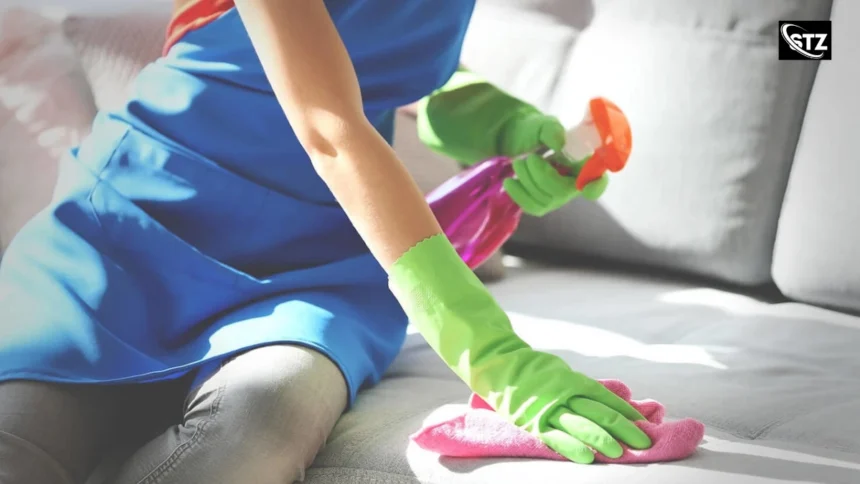Mold on fabric furniture is a common yet concerning problem, particularly in humid environments like kitchens, bathrooms, or basements. If left untreated, mold can damage the fabric, create unpleasant odors, and even pose health risks. Fortunately, there are effective methods to eliminate mold from fabric furniture. Here’s a step-by-step guide on how to do so:
What is Mold?
Mold is a type of fungus that thrives in moist and humid environments. It can be microscopic, spreading through the air in the form of spores. Mold can appear in various colors and forms, and it can grow on organic surfaces such as wood, paper, and fabric when exposed to excess moisture. It’s a common issue in homes, especially in areas with high humidity levels.
What Are the Harms of Mold to Our Health?
Mold isn’t just an eyesore; it can also be harmful to our health, especially when inhaled. Mold releases spores that can trigger allergic reactions, respiratory problems, and other health issues.
- Severe Allergies: Mold spores can trigger allergic reactions such as coughing, wheezing, shortness of breath, and skin irritation. Those with mold allergies or respiratory conditions are especially vulnerable.
- Lung Inflammations: Mold can lead to more severe conditions such as lung inflammation. Aspergillus, a type of mold, can cause this disease, particularly in individuals with weakened immune systems, such as cancer patients or those on long-term steroid medication.
- Damages to Nerve Cells: Some molds release mycotoxins that can harm nerve cells and lead to neurological problems. Inhalation of these toxins can result in symptoms like headaches, dizziness, and even mental health issues like depression or anxiety.
How to Prevent and Get Rid of Mold in Homes
To prevent mold growth in your home, it’s essential to reduce indoor humidity levels and ensure proper ventilation. Regularly airing out your home, particularly in the kitchen and bathroom, can help control moisture. Also, repair leaking pipes and avoid drying laundry indoors. Using dehumidifiers and ensuring proper airflow around furniture can also prevent mold.
For furniture, it’s crucial to clean mold promptly to avoid it from spreading. Items such as towels, cushions, and rugs in high-humidity areas should be dried thoroughly after use.
4 Methods to Remove Mold from Furniture Fabric
Here are four effective methods to remove mold from fabric furniture:
- Use Vinegar: Vinegar is a powerful natural mold killer. Mix equal parts white vinegar and water in a spray bottle. Apply it to the affected areas and let it sit for 10 minutes. Wipe off the mold with a clean cloth. Vinegar not only removes mold but also helps prevent future growth.
- Use Carbonated Water or Baking Soda: If you don’t have vinegar, carbonated water is a great alternative. The carbonation will help lift the mold to the surface. Baking soda is also effective in removing mold and preventing it from returning. Mix it with water and scrub the moldy fabric gently.
- Use Liquid Soap: For light mold, a mixture of liquid soap and water can be used. This method is gentler and ideal for fabrics that may be more delicate. Simply mix soap and water, apply it to the fabric, and scrub lightly.
- Use Clove Oil and Salt: For a natural approach, combine three drops of clove oil, one tablespoon of vinegar, and half a liter of water. Apply this mixture to the fabric and sprinkle salt over it. Let it dry overnight and vacuum it the next day.
Understanding Mold: Mold grows in areas with high humidity and moisture. It thrives on organic materials like fabric, wood, and paper. Mold can develop on furniture when exposed to damp conditions, often due to water leaks or high indoor humidity.
Health Risks of Mold: Mold spores can trigger allergic reactions, respiratory problems, and severe conditions like lung inflammation. They can also damage nerve cells and affect mental health.
Mold Prevention and Removal: Reducing moisture and humidity, fixing leaks, and improving ventilation are key to preventing mold. When mold does appear, natural remedies like vinegar, baking soda, and clove oil can be effective in removing it from fabric furniture.
By following these steps, you can maintain a healthy and mold-free environment in your home while preserving your furniture’s integrity.
Final Thoughts
Mold growth on fabric furniture is a common issue that can lead to significant damage to both the furniture and your health. Timely intervention is essential to prevent the mold from spreading and causing further harm. Understanding the causes of mold formation, such as high humidity and poor ventilation, can help you take proactive measures to minimize its presence. When dealing with mold on fabric, using natural solutions like vinegar, baking soda, or clove oil can be highly effective. However, it’s crucial to understand when a DIY solution is not enough and professional help is needed, especially for delicate fabrics or severe mold infestations.
Frequently Asked Questions (FAQs)
1. How do I know if my fabric furniture has mold?
Mold can appear as dark spots or patches on your furniture, and it may have a musty or earthy smell. In some cases, it might not be visible but can be detected by the smell. If your furniture has been exposed to moisture or humidity for an extended period, it’s a good idea to check for mold.
2. Can mold on fabric furniture be dangerous to my health?
Yes, mold can trigger allergic reactions, respiratory problems, and more serious health issues, especially for children, the elderly, or those with weakened immune systems. Mold exposure can lead to symptoms like coughing, sneezing, and wheezing.
3. What is the best method for removing mold from fabric furniture?
The most effective methods for removing mold include using vinegar, baking soda, or hydrogen peroxide. These natural cleaning agents are powerful against mold without damaging the fabric. However, always test them on a small, inconspicuous area first to ensure the fabric won’t discolor.
4. How can I prevent mold from growing on my fabric furniture?
To prevent mold growth, keep your furniture dry, use dehumidifiers, and regularly ventilate your home. Ensure your furniture is not placed against walls where moisture can accumulate, and avoid leaving wet items on fabric surfaces.
5. When should I call a professional to remove mold from furniture?
If the mold growth is extensive, or the fabric is delicate (like silk or wool), it’s best to call a professional mold removal service. They can use specialized techniques and cleaning agents to safely remove the mold without damaging the fabric.
6. Can I use bleach to remove mold from fabric furniture?
While bleach is effective for mold removal, it can damage delicate fabrics and discolor them. It is recommended to use milder solutions like vinegar, baking soda, or hydrogen peroxide to safely clean fabric furniture.
7. How do I treat mold on fabric that can’t be washed?
For fabric that cannot be washed, such as upholstery or cushions, try using a solution of hydrogen peroxide or vinegar. Apply the solution to the affected area, then rinse and dry thoroughly. If the fabric is too delicate, consider professional cleaning.
8. Can mold cause permanent damage to my furniture?
If not treated quickly, mold can weaken the fabric and lead to irreversible damage such as holes, tears, or discoloration. Early treatment can help prevent permanent damage and restore your furniture’s appearance.








